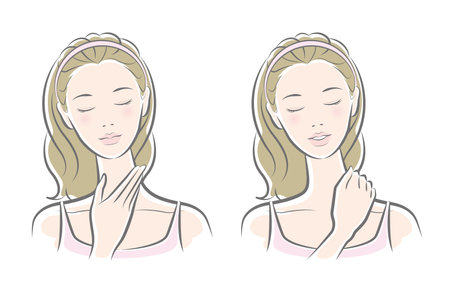1. Understanding How Hormones Affect Skin Aging
When we talk about skin aging after 40, it’s impossible to ignore the powerful role hormones play. These tiny messengers control many processes in our bodies, and as their levels shift with age, they directly impact how our skin looks and feels. Let’s break down the main hormones involved and how each one affects your skin over time.
Key Hormones That Influence Skin Health
| Hormone | Main Function | Effect on Skin as We Age |
|---|---|---|
| Estrogen | Supports collagen production and moisture retention | Decline leads to thinner, drier skin and more wrinkles |
| Testosterone | Regulates oil production and skin thickness | Decrease can cause dryness; imbalance may trigger adult acne or dullness |
| Cortisol (Stress Hormone) | Manages stress response and inflammation | Chronic elevation breaks down collagen, causing sagging and slower healing |
| Thyroid Hormones | Control metabolism and skin cell turnover | Imbalances can lead to dry, rough, or puffy skin and even hair loss around the scalp and brows |
How Hormonal Changes Show Up on Your Skin After 40
Your 40s often mark the start of significant hormonal shifts—especially for women entering perimenopause or menopause, but also for men experiencing gradual drops in testosterone. Here’s what you might notice:
- Loss of Firmness: Lower estrogen slows collagen production, making skin less bouncy.
- Dryness and Sensitivity: Less oil from reduced testosterone and estrogen means more dryness or irritation.
- Fine Lines and Wrinkles: Collagen loss plus environmental stress speeds up visible aging.
- Pigmentation Changes: Hormonal fluctuations can trigger dark spots or uneven tone.
- Puffiness: Thyroid issues may cause swelling or a “tired” look around eyes and face.
The Hormone–Skin Connection in Everyday Life
You may not see these changes overnight, but over time, hormonal shifts influence everything from how well your moisturizer works to how quickly your skin heals after a breakout. Knowing which hormone is at play helps you choose targeted skincare routines or lifestyle tweaks that actually work for your age—and your unique hormonal profile.
2. Visible Signs of Hormonal Skin Changes After 40
If you’ve noticed your skin isn’t quite the same after 40, you’re definitely not alone. As we age, our hormones—especially estrogen and testosterone—begin to fluctuate, and these changes can have a big impact on how our skin looks and feels. Let’s break down the common signs you might see and how they’re connected to hormonal shifts.
How Hormonal Changes Affect Your Skin
Hormones act like messengers in your body, telling your skin cells how to behave. When these messages change, your skin’s appearance and texture often change too. Here are some typical signs that hormonal changes may be showing up on your skin:
| Skin Change | What You Might Notice | Linked Hormonal Shift |
|---|---|---|
| Dryness | Tightness, flakiness, dullness | Drop in estrogen reduces natural oils |
| Loss of Elasticity | Sagging, less bounce-back, fine lines appearing faster | Less collagen production as hormones decline |
| Wrinkles | Crow’s feet, smile lines, deeper forehead lines | Lower estrogen = thinner, less plump skin |
| Adult Acne | Pimples or cystic acne on jawline or chin area | Testosterone spikes and estrogen dips throw off oil balance |
| Increased Sensitivity | Easily irritated, redness or stinging after using products you once loved | Thinner skin barrier from hormonal loss |
| Uneven Tone & Dark Spots | Patches of discoloration or “age spots” appearing more often | Estrogen decline impacts melanin regulation in skin cells |
The American Experience: Real Stories and Everyday Impact
If you’re living in the U.S., you might notice these changes especially during stressful times (like work deadlines or family transitions) or when going through major life stages such as menopause. Many people find themselves searching for new skincare routines or asking their dermatologist about sudden adult acne flare-ups or dry patches that seem to show up overnight. It’s totally normal to feel frustrated—but understanding that hormones are a big part of this process can make it easier to manage.
Quick Tip: Listen to Your Skin!
Your skin is basically sending signals about what’s happening inside your body. If something doesn’t feel right or you notice sudden changes—like persistent dryness or breakouts—it’s a good idea to check in with a healthcare provider or dermatologist. They can help tailor advice for your unique needs as you navigate these hormonal shifts.
![]()
3. Lifestyle Habits to Support Healthy Hormone Balance
Practical Ways to Keep Your Hormones—and Skin—Happy After 40
As we age, our hormones naturally shift, which can lead to visible changes in our skin. The good news? Your daily habits have a real impact on how your hormones behave and how your skin ages. Here’s how you can support hormone balance and keep your skin looking its best well into your 40s and beyond.
Stress Less for Smoother Skin
Chronic stress isn’t just tough on your mood—it ramps up cortisol, which can break down collagen and speed up wrinkles or sagging. Try these stress-busters:
- Mindful moments: Even 5-10 minutes of meditation, deep breathing, or gentle yoga can help lower stress hormones.
- Connect with others: Chatting or laughing with friends releases feel-good chemicals that buffer the effects of stress.
- Unplug before bed: Screen time late at night can ramp up stress and mess with sleep, so set a “tech curfew.”
Snooze for Hormonal Harmony
Your body balances hormones like melatonin and growth hormone while you sleep—both essential for skin repair. Aim for quality rest:
| Sleep Tip | Why It Helps |
|---|---|
| Stick to a schedule | Keeps your internal clock steady, making it easier to fall asleep and wake up refreshed |
| Create a bedtime ritual | Tells your body it’s time to wind down; think warm tea, soft music, or reading |
| Keep your room cool & dark | Supports deeper sleep and natural hormone production |
Nourish from Within: Eat for Balanced Hormones
Your diet plays a big role in supporting healthy skin and balanced hormones. Focus on:
- Healthy fats: Avocados, nuts, olive oil, and fatty fish help produce skin-supportive hormones like estrogen.
- Colorful fruits & veggies: Loaded with antioxidants that fight skin aging.
- Avoiding excess sugar: Too much sugar spikes insulin, which can throw off other hormones and contribute to dull or breakout-prone skin.
- Staying hydrated: Water supports every cell in your body—including those that build healthy skin.
Move Your Body for Better Balance
You don’t need to run marathons! Regular movement keeps hormones in check and boosts circulation for glowing skin. Try:
- Brisk walks: A daily stroll gets your blood moving without stressing your joints.
- Pilates or yoga: These are gentle on the body but great for building strength and reducing stress hormones.
- Dancing or group classes: Add fun to fitness while socializing—a double win for mood-balancing!
Your Daily Checklist for Hormone-Friendly Habits
| Lifestyle Area | Simple Action Step |
|---|---|
| Stress Management | Breathe deeply for 1 minute when feeling tense |
| Sleep Routine | Aim for 7-8 hours each night, same bedtime/wake-up time daily |
| Nutrition Choices | Add one extra serving of veggies to lunch or dinner each day |
| Physical Activity | Sneak in 20-30 minutes of movement most days (walk, stretch, dance) |
Tuning into these lifestyle habits doesn’t just help balance hormones—they’re small changes that add up to healthier, happier skin as the years go by.
4. Powerful Skincare Ingredients and Routines for Mature Skin
When you’re over 40, hormonal changes can make your skin look and feel different. Estrogen drops, collagen production slows down, and you might notice more dryness or fine lines. The right skincare can really help! Here’s a simple guide to the most effective ingredients and routines designed for mature, hormonally aging skin.
Must-Have Ingredients for Hormonal Skin Aging
| Ingredient | What It Does | Why It Works for Over 40 |
|---|---|---|
| Retinoids (Retinol, Tretinoin) | Smooths wrinkles, boosts collagen, fades spots | Helps reverse visible signs of aging caused by hormone shifts |
| Peptides | Supports collagen and elastin production | Improves firmness as natural levels decline with age |
| Antioxidants (Vitamin C, E, Green Tea) | Protects against environmental damage, brightens skin | Counters free radicals that speed up aging when estrogen drops |
| Hyaluronic Acid | Deep hydration, plumps fine lines | Tackles dryness common after 40 due to lower oil production |
| Ceramides & Fatty Acids | Rebuilds skin barrier, locks in moisture | Restores resilience as skin becomes thinner post-menopause |
| Niacinamide (Vitamin B3) | Evens tone, calms redness, strengthens barrier | Soothes sensitivity and discoloration from hormonal changes |
Easy Skincare Routine for Mature Skin
AM Routine:
- Gentle Cleanser: Avoid harsh soaps that strip moisture.
- Antioxidant Serum: A Vitamin C serum protects and brightens.
- Moisturizer: Look for hyaluronic acid or ceramides.
- Sunscreen (SPF 30+): Essential every day—even if you’re indoors!
PM Routine:
- Mild Cleanser: Remove makeup and impurities gently.
- Treatment Serum: Use retinoids or peptides at night to repair skin.
- Nourishing Moisturizer: Go richer at night to fight overnight water loss.
- (Optional) Face Oil: Adds extra comfort if your skin feels tight.
TIPS FOR SUCCESS:
- If you’re new to retinoids, start slow—just a couple of nights per week—and increase as your skin gets used to it.
- You can layer products, but go from thinnest (serums) to thickest (moisturizer).
- If you have sensitive skin, patch-test new ingredients before full use.
- Avoid using retinoids and strong exfoliants (like AHAs/BHAs) together on the same night to prevent irritation.
- If you notice major changes in your skin during menopause or perimenopause, consider talking with a dermatologist about prescription options.
5. Medical & Professional Interventions
When it comes to managing the effects of hormones on skin aging after 40, sometimes over-the-counter products and lifestyle tweaks just aren’t enough. That’s when medical and professional interventions can make a real difference. If you’re curious about what’s available, here’s a straightforward look at your options in the U.S.—from hormone replacement therapy (HRT) to dermatological procedures, plus why working with board-certified professionals matters.
Hormone Replacement Therapy (HRT)
One major shift that happens as we age—especially for women during menopause—is a drop in estrogen and other hormones that help keep skin firm and hydrated. HRT is a medical treatment designed to supplement these hormones, which can help improve skin thickness, elasticity, and moisture. It’s not a one-size-fits-all solution; your provider will weigh benefits and risks based on your health history.
| Type of HRT | How Its Used | Main Benefits |
|---|---|---|
| Estrogen Therapy | Pills, patches, creams | Improves skin hydration & elasticity |
| Combination Therapy | Pills or patches (estrogen + progestin) | Balances hormone levels for women with a uterus |
| Bioidentical Hormones | Custom-compounded creams or lozenges | Aimed at mimicking natural hormones (effectiveness debated) |
Important Note:
HRT isn’t right for everyone. It may increase certain health risks, so always consult a board-certified healthcare provider before starting any hormonal treatments.
Dermatological Procedures
If you want more immediate or targeted results, dermatologists offer a range of treatments that address hormone-related skin changes:
| Procedure | What It Does | Typical Results |
|---|---|---|
| Chemical Peels | Removes top layers of skin to reveal fresher, smoother texture underneath | Softer lines, improved tone and glow |
| Microneedling | Tiny needles stimulate collagen production by creating micro-injuries | Firmer, plumper-looking skin over time |
| Laser Treatments | Uses focused light to boost collagen & reduce pigmentation or redness | Smoother texture, more even color, less sagging |
| Injectables (Botox/fillers) | Smooth wrinkles or restore lost volume due to hormonal changes | Younger-looking contours, fewer deep lines |
Working With Board-Certified Providers Matters
No matter which route you’re considering—HRT, peels, lasers, or injectables—it’s super important to work with board-certified professionals. These experts have specialized training and understand how hormonal shifts uniquely affect your skin after 40. They’ll create safe plans tailored just for you.
The Bottom Line on Professional Help:
- If your home routine isn’t doing enough, talk openly with a dermatologist or endocrinologist.
- A personalized approach gives the best shot at healthy, vibrant skin through your 40s and beyond.
- Your safety—and confidence—always come first when choosing any intervention.
If you’re thinking about any of these options, don’t hesitate to book a consultation with a licensed expert. They can guide you through all the choices and help you feel empowered about your skin at every age.
6. Embracing Body Positivity and Self-Confidence
As we explore how hormones impact skin aging after 40, its important to look beyond just skincare routines and medical treatments. In the United States, theres a growing movement towards body positivity and embracing every stage of life—including the natural changes that come with aging. Feeling confident in your own skin is just as essential as any serum or moisturizer you use.
The Power of a Positive Mindset
Hormonal changes can lead to visible signs of aging like wrinkles, dryness, or sagging. While these are normal parts of getting older, they can sometimes affect how we feel about ourselves. Building self-esteem and maintaining a positive self-image helps counteract negative stereotypes about aging and beauty. Remember, beauty doesn’t have an age limit—every wrinkle and laugh line tells your unique story.
Holistic Approaches to Aging Well
Taking care of your skin isn’t only about what you put on it—it’s also about how you treat yourself from the inside out. Here’s a quick guide to holistic well-being for skin health:
| Self-Care Practice | How It Helps |
|---|---|
| Healthy Diet | Nourishes your skin and supports hormonal balance |
| Regular Exercise | Boosts mood, circulation, and skin radiance |
| Mindfulness & Stress Reduction | Lowers cortisol levels that can affect skin health |
| Positive Social Connections | Builds confidence and emotional support |
| Acknowledging Achievements | Reminds you of your strengths beyond appearance |
Diverse Perspectives on Beauty in America
American culture is incredibly diverse, with countless backgrounds and experiences shaping our ideas of beauty. Whether youre celebrating your natural hair texture, your cultural heritage, or the wisdom that comes with age, embracing what makes you unique is powerful. Every community has its own standards of beauty—and all are valid.
Tips for Boosting Self-Confidence Over 40
- Practice gratitude for what your body does for you every day.
- Follow social media accounts that promote inclusive and realistic images of aging.
- Share your journey with friends or support groups who uplift you.
- Treat yourself kindly—inside and out.
- Focus on healthy habits rather than chasing perfection.
The journey through hormonal changes and skin aging is different for everyone, but choosing self-love and acceptance is always in style. By combining science-backed skincare with a holistic, compassionate approach to aging, you’ll shine at every stage of life—just as you are.


